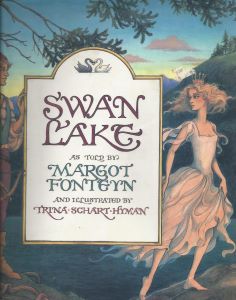Swan Lake (Adaptation)

Content:
Swan Lake
Illustrator:
Trina Schart Hyman
Margot Fonteyn
Publication:
1989 by Andersen Press
Genre:
Dance, Fairy Tales, Fiction, Picture Books
Pages:
32
Current state:
This book has been evaluated and information added. It has been read but content considerations may not be complete.
Book Guide
Search for this book used on:
The lights dim, the house grows still, and the curtains part to reveal the haunting beauty of Swan Lake. Once again, ballerina Margot Fonteyn enchants audiences—this time to tell the tale of the doomed lovers as only she can.
The age-old legend in which a lovely princess, turned into a swan by an evil enchanter, is rescued by a handsome young prince has become one of the world's best-loved ballets. And the story takes on yet another form as the graceful figures in Trina Schart Hyman's illustrations float magically across the pages.
Swan Lake as told by Margot Fonteyn and illustrated by Trina Schart Hyman will be treasured as dearly by those who already love the ballet as by those who have yet to fall under its spell.
From the dust jacket
To view an example page please sign in.
Resource Guide
Episode 70: Why Read Fairy Tales?
Released in 2020 by The Literary Life
Available formats: Streaming Audio
Length: 1 hr. 29 min.
View on the The Literary Life site
"Angelina Stanford and Cindy Rollins tackle the topic of fairy stories, discussing the what, why and how of reading them. Angelina shares the distinctive characteristics of fairy stories in contrast to other types of stories, such as myths. They deal with the question of whether fairy tales are 'escapist', the influence of the Grimm brothers scholarly work on interpreting fairy stories, and allowing the story to unveil its deeper truths without forcing meaning onto it.
Angelina gives an illustration of how to see the gospel messages in fairy tales by talking us through the story of Sleeping Beauty. She refutes the ideas that fairy tales are about human romance or are misogynistic. She also highlights some of the Enlightenment and Puritan responses to fairy tales that still linger with us today. Cindy and Angelina also discuss some common concerns such as the magical, weird, or scary aspects of fairy tales. Angelina also makes a distinction between folk tales, literary fairy tales, and cautionary tales."
Find This Book
Search for this book used on:



